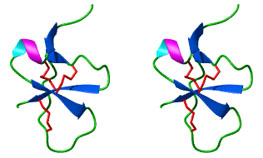| What is a Platypus?
Platypus venom
causes pain in humans:
What makes platypus venom unique? Current knowledge on Platypus venom |

* Courtesy of <http://psel.uchc.edu/structures.html> * |
| What is a Platypus?
Platypus venom
causes pain in humans:
What makes platypus venom unique? Current knowledge on Platypus venom |

* Courtesy of <http://psel.uchc.edu/structures.html> * |
Current Knowledge on Platypus Venom
Platypus venom research is a extremely new study and there is not much know about how it takes effect on the body or the components of the venom. Thus far in research a family of four polypeptides have been identified in in platypus venom. These polypeptides have been called DLPs or defensin-like peptides. They are unique because their amino acid sequences are unlike any documented in the SwissProt database or the Quest Protein database database in Cold Springs Harbor. However, the tertiary structure of one of the polypeptides, DLP-1, ( see picture above ) was similar to the tertiary structure of the beta defensin-12 peptide, and sodium neurotoxin peptide ShI that is found in sea anemones. Platypus venom contains several protein components. Two components that have been studied the most are a C-type natriuretic peptide ( OvCNP ) and a nerve growth factor protein ( OvNGF ). The C-type natriuretic peptide has been shown to cause relaxation in the uterus of a rat, cause histamine release in mast cells and cause tissue oedema. Unfortunately current studies on OvCNP have been unable to identify the role that OvCNP plays in platypus venom. The nerve growth factor protein is thought to cause the pain inducing stimulus in the venom and is currently being studied further. Studies into OvNGF have also failed to prove any theories that would explain the importance of OvNGF in the venom. Basically, platypus venom is a wholly unique substance and cannot be substantially compared to any other documented proteins on earth. Equally unique is the venom's effects on the human body. The quantity of information on both platypus venom and the mechanisms that govern the sensation of pain in human beings is very limited. However, progress is being made at a exponential rate and is already showing significant results such as the identification of DLPs in platypus venom and the existence of opiate receptors in the spinal cord.